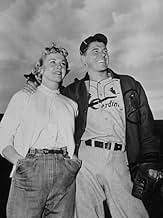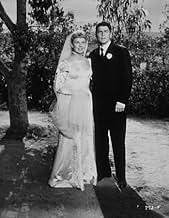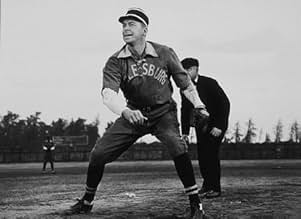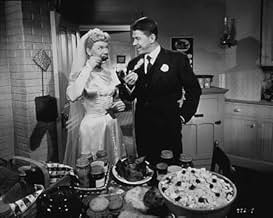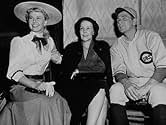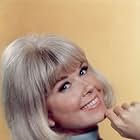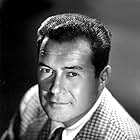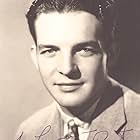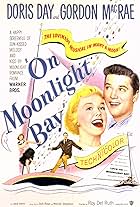Nebraska farmboy Grover Cleveland Alexander achieves baseball stardom before war injuries and alcoholism derail his career, but through his wife's faithful efforts he gets a chance for a com... Read allNebraska farmboy Grover Cleveland Alexander achieves baseball stardom before war injuries and alcoholism derail his career, but through his wife's faithful efforts he gets a chance for a comeback and redemption.Nebraska farmboy Grover Cleveland Alexander achieves baseball stardom before war injuries and alcoholism derail his career, but through his wife's faithful efforts he gets a chance for a comeback and redemption.
- Willie Alexander
- (as Rusty Tamblyn)
- Baseball Player
- (as Peanuts Lowrey)
- Baseball Player
- (as Irving Noren)
Storyline
Did you know
- TriviaAccording to TMC, Ronald Reagan had lobbied hard to play the title role in "The Stratton Story" (1949) but Warner Bothers didn't want to take a chance on a baseball film and passed on the project. After "The Stratton Story" became a huge hit, the studio picked up the Grover Cleveland Alexander story about another player who made a comeback after being forced from professional baseball.
- GoofsThe film ends with the 1926 World Series, and Grover Cleveland Alexander retired from baseball in 1930, yet he is seen with a number on the back of his jersey, a practice that did not begin until 1931. Because he never wore a number on his uniform, there was no number for teams to "retire" for this great player. Therefore the Philadelphia Phillies retired the block letter-style "P" from their 1915 uniforms to honor Alexander.
- Quotes
Aimee Alexander: [while Grover is hospitalized, having been beaned by a baseball] What's the matter?
Grover Cleveland Alexander: Nothing, I'm twice as good as I ever was... I'm seeing two of everything.
- ConnectionsFeatured in Diamonds on the Silver Screen (1992)
- SoundtracksTake Me Out to the Ball Game
(uncredited)
Music by Albert von Tilzer
Lyrics by Jack Norworth
Played during the opening credits and sung by Doris Day
Grover Cleveland "Old Pete" Alexander lived from 1887 to 1950. He was a Major League Baseball pitcher for the Philadelphia Phillies, Chicago Cubs, and St. Louis Cardinals. He was elected to the Baseball Hall of Fame in 1938. In his 1911 debut, Alexander led the league with 28 wins (a modern-day rookie record), 31 complete games, 367 innings pitched, and seven shutouts. He was drafted into WWI and in France was an artillery officer, where he suffered from shell shock and partial hearing loss. Injuries from playing baseball and battle fatigue lead to more physical problems and alcoholism. After the film was finished Ronald Reagan was disappointed that it was not made more clear that Alexander suffered from Epilepsy, the studio banned the use of the word in the film because of a social stigma at the time. Modern examples of controversy might include living legends Pete Rose and Mark McGuire. But it has been suggested that the drinking was due to his fear (which the film touches on) from not understand epilepsy and the seizures that he had. Notable Achievements include: 373 career wins (3rd all-time); Won 20 games or more 9 times, won 30 games or more 3 times; Pitched 90 shutouts (2nd all time); Won NL Pitcher's Triple Crown in 1915, 1916, 1917 and 1920; World Series champion (1926); National League pennants (1915), (1918) In 1999 he was ranked number 12 on The Sporting News list of the 100 Greatest Ballplayers of all time.
Ronald Reagan best known as our 40th President, started his acting career as a sports caster in Des Moines, Iowa which led to being a play-by-play announcer for the Chicago Cubs. In 1937 he moved to Hollywood and debuted in LOVE IS IN THE AIR. He appeared in dozens of B films. In the 1939 Bette Davis "A" film DARK VICTORY, Reagan got good notices which led to better roles as in George Gipp (win this one for the "Gipper") in the sports bio KNUTE ROCKNE: ALL American and George Armstrong Custer in SANTE FE TRAIL. He was never Oscar nominated but many consider his role in KINGS ROW to be his best performance. In 1951 he made his first film with Doris Day, it was a KKK drama called STORM WARNING. During the 1950s he was a democrat and fought communism as the head of the Screen Actors Guild and while working in television as host of the General Electric Theater he switched to the Republican Party in 1962. He met his wife Nancy Davis while making the film HELLCATS OF THE NAVY. His last film was THE KILLERS in 1964. In 1966 he was elected Governor of California and the rest they say is history.
Doris Day turned 87 this past April 3rd, she was born Doris Mary Ann Von Kappelhoff in Evanston, Ohio. At 14 she won a talent contest on a Cincinnati radio, the band leader joked she should change her name to something shorter for a marquee. The song she sang was "Day by Day." Doris Day was soon discovered by band leader Les Brown and their hit SENTIMENTAL JOURNEY sent her to Hollywood where she made ROMANCE ON THE HIGH SEAS in 1948. Her song, "IT'S MAGIC" was Oscar nominated for best song. Among her many film highlights are CALAMITY JANE, TEACHER'S PET (her favorite), LOVE ME OR LEAVE ME, THE PAJAMA GAME, Hitchcock's THE MAN WHO KNEW TOO MUCH, THAT TOUCH OF MINK and PILLOW TALK (my favorite) where she was Oscar nominated for Best Leading Actress. Her TV career included THE DORIS DAY SHOW, DORIS DAY TODAY & DORIS DAY'S BEST FRIENDS. She is now retired, living in Carmel California, a full-time vegetarian and an animal rights activist.
3rd billed Frank Lovejoy plays Rogers Hornsby another ballplayer who befriends Alexander. You may not remember his name but you will recognize him, square-jawed, intense, no-nonsense Frank Lovejoy played a succession of detectives, street cops, reporters and soldiers in films. He made his Broadway debut in 1934 and with his gritty, authoritative voice was perfect for radio making thousands of old time radio show appearances on "Gangbusters", "Night Beat" and "Damon Runyon Theater".
- Larry41OnEbay-2
- May 10, 2009
- Permalink
- How long is The Winning Team?Powered by Alexa
Details
- Runtime1 hour 38 minutes
- Color
- Aspect ratio
- 1.37 : 1
Contribute to this page




